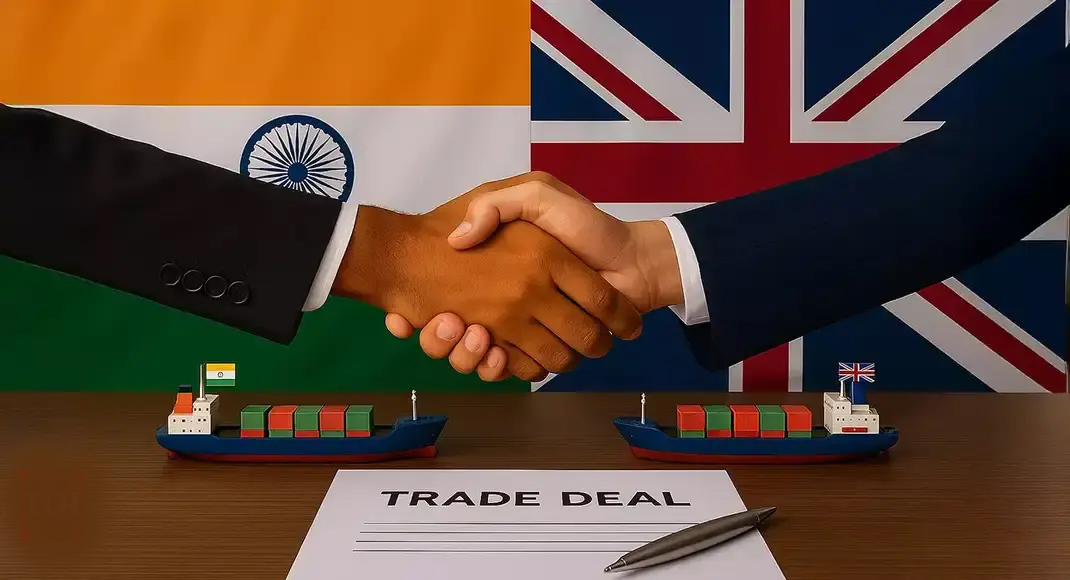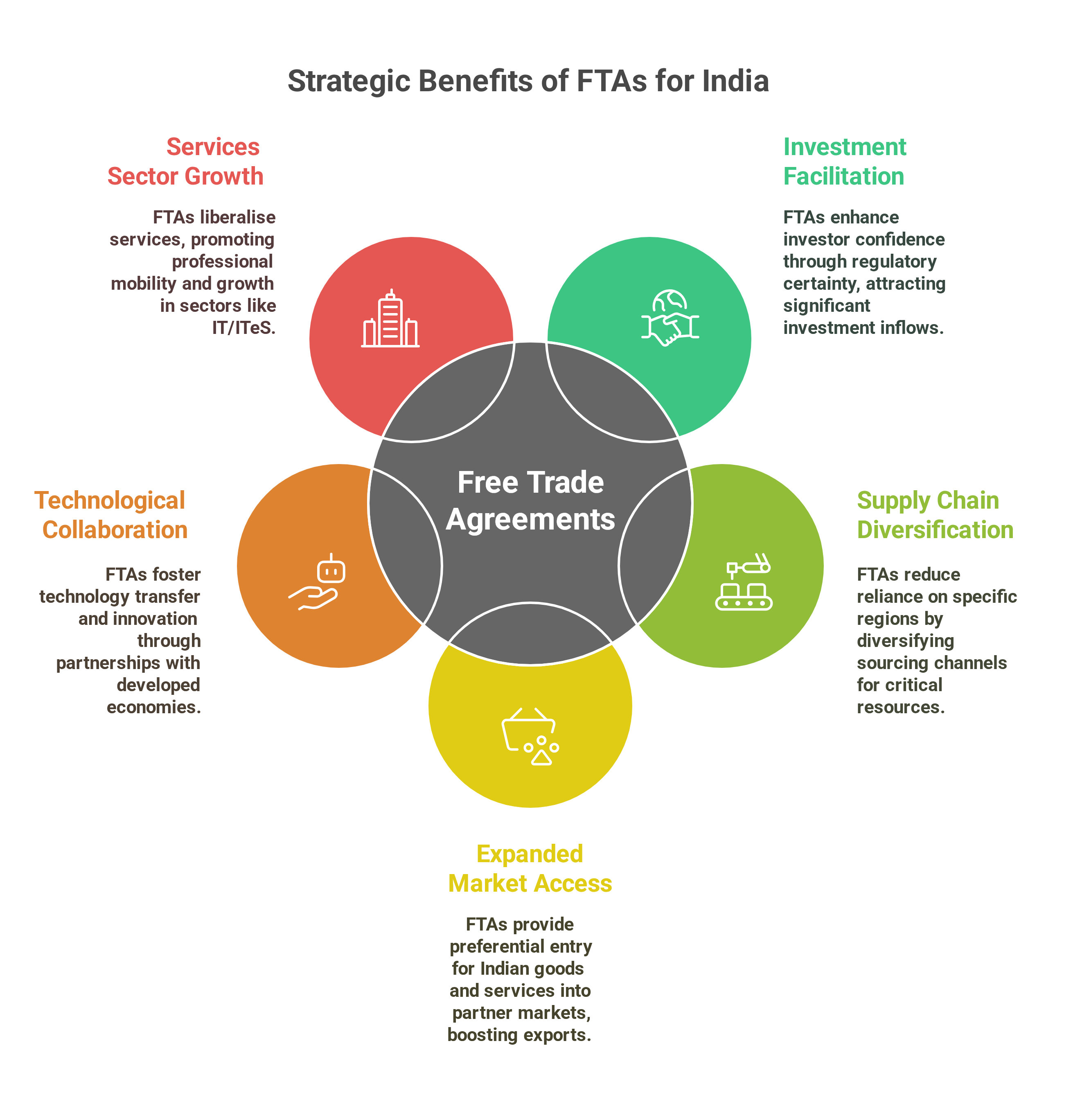India and the United Kingdom have concluded negotiations on a long-pending Free Trade Agreement (FTA), marking a pivotal moment in their bilateral economic relations. The final agreement, which follows over three years of negotiations and thirteen rounds of deliberations, is set to be officially ratified during an upcoming meeting between the Prime Ministers of both nations. The deal is being projected as a catalyst for trade, investment, job creation, and innovation across sectors.
Understanding Free Trade Agreements (FTAs):
A Free Trade Agreement is a binding accord between two or more countries to reduce or eliminate tariffs, import quotas, and preferences on most goods and services traded. Unlike Preferential Trade Agreements (PTAs), which provide limited tariff reductions on selected goods, FTAs cover a broader range of trade categories and offer near-complete tariff liberalisation.
Core Objectives of FTAs Include:
- Reduction in Customs Duties: Typically aimed at eliminating tariffs on 90–95% of traded goods.
- Removal of Non-Tariff Barriers: Seeks to simplify or eliminate regulatory hurdles, standards, and bureaucratic delays that inhibit trade.
- Facilitation of Services and Investment: Eases norms for services trade and fosters an investment-friendly regulatory environment.
Significance of the FTA:
- The agreement holds considerable strategic and economic value for both countries. It is particularly notable in the context of ongoing global trade uncertainties and rising protectionist tendencies. For India, the FTA comes at a time when its trade surplus with the U.K. provides a favorable platform for exports. In 2024, India was the U.K.’s 11th-largest trading partner, contributing to 2.4% of its overall trade. The British government has projected that bilateral trade could rise by $34.05 billion following the implementation of the agreement.
- From the U.K.’s perspective, the FTA represents one of the most substantial post-Brexit trade deals, following previous failed attempts by Conservative leaders Boris Johnson and Liz Truss. The agreement materialized under the Labour government led by Keir Starmer after a breakthrough meeting with Indian Prime Minister Narendra Modi during the G20 Summit.
Key Provisions of the Trade Deal:
While the complete text of the agreement remains undisclosed, official statements have outlined several pivotal features:
-
Tariff Reductions:
- India will reduce tariffs on 90% of products, with 85% becoming fully tariff-free within ten years.
- The U.K. will eliminate tariffs on 99% of imported goods from India.
- Indian exporters are likely to benefit in sectors such as textiles, leather, footwear, auto components, engineering goods, gems and jewellery.
-
Alcohol and Automotive Sectors:
- Tariffs on whiskey and gin will be reduced from 150% to 75%, further declining to 40% within a decade.
- Automotive tariffs, previously over 100%, will be reduced to 10%, though these changes are subject to quota restrictions.
- Services and Professional Mobility:
The agreement includes a significant provision under the Double Contribution Convention, allowing Indian workers temporarily posted in the U.K. and their employers to be exempt from paying social security contributions for up to three years. This clause is expected to enhance the mobility of professionals in IT, financial, professional, and educational services.
Economic and Sectoral Impact:
- The apparel sector, represented by the Apparel Export Promotion Council (AEPC), has expressed optimism regarding a significant surge in exports. India currently faces competition from countries like Bangladesh and Vietnam, which already enjoy duty-free access to U.K. markets. Tariff elimination will enhance India’s competitiveness, particularly since imports from the U.K. in this sector are minimal.
- The Gems and Jewellery sector also anticipates a rise in trade volumes. According to the Gems and Jewellery Export Promotion Council (GJEPC), exports in this sector are projected to grow by $2.5 billion within the next two years.
- Other major export categories from India to the U.K., as per the Ministry of Commerce’s TradeStat database, include:
- Pharmaceuticals
- Knit and non-knit apparel
- Electrical machinery and equipment
- Pharmaceuticals
Possible challenges:
- Carbon Border Adjustment Mechanism (CBAM):
CBAM could impose levies on Indian exports like steel and aluminium based on their carbon emissions, while British goods may enter India without similar constraints. The FTA reportedly does not address this asymmetry, potentially placing Indian manufacturers at a disadvantage. - Investor-State Dispute Settlement (ISDS):
Despite substantial foreign direct investment flows—$23.3 billion from the U.K. to India and $17.5 billion in the reverse—the agreement lacks a dedicated investor protection mechanism. This raises concerns about dispute resolution and legal recourse for businesses on both sides.
Public Procurement Access:
Another crucial clause grants U.K. firms access to India’s public procurement market, allowing them to bid for government contracts on favorable terms. While this opens up competitive opportunities, it also raises apprehensions about increased import reliance and the erosion of domestic industrial sovereignty.
Strategic Significance of FTAs for India:
- Investment Facilitation: FTAs offer regulatory certainty that enhances investor confidence. The recently concluded India-EFTA agreement promises an investment inflow of USD 100 billion over 15 years, aiding initiatives like Make in India and employment generation.
- Supply Chain Diversification: By diversifying sourcing channels, FTAs reduce over-reliance on specific geographies. Agreements with countries like Australia (under the ECTA) provide access to critical minerals vital for electric vehicle and green technology sectors.
- Expanded Market Access: FTAs allow Indian goods and services preferential entry into partner markets. For instance, the India-UAE CEPA led to an 11.8% surge in exports, particularly in textiles, engineering goods, and jewellery.
- Technological Collaboration: Collaborations with developed economies under FTAs create avenues for technology transfer. The India-Japan CEPA and India-EFTA agreements illustrate this through initiatives in advanced manufacturing and digital innovation.
- Services Sector Growth: FTAs support liberalisation of services, facilitating mobility of professionals, mutual recognition of qualifications, and simplified visa regimes. Provisions in India’s FTAs with Australia and the UAE have notably boosted IT/ITeS exports and created opportunities for Indian professionals.
Conclusion:
The India–U.K. FTA is a landmark development with the potential to reshape economic engagement between the two democracies. While the agreement unlocks opportunities for trade, investment, and professional mobility, it also necessitates a calibrated approach to mitigate risks for vulnerable sectors. Industrial policy alignment, environmental safeguards, and balanced market access will be critical to ensuring that the agreement fosters inclusive and sustainable growth.
| Main question: “FTAs are a double-edged sword for developing economies.” In light of the India–UK FTA, discuss the opportunities and challenges FTAs present for India’s sovereignty over public procurement and domestic industries. |








